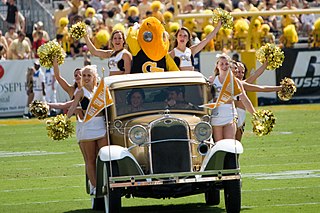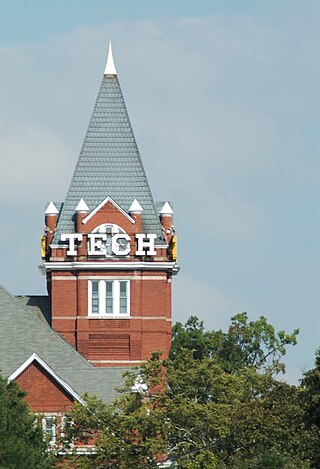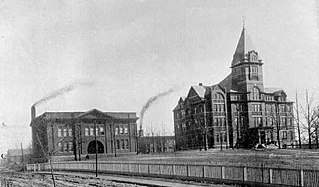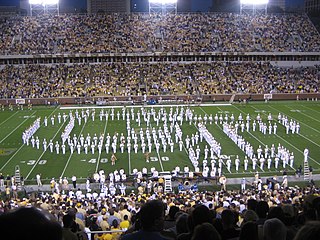D. Kimbrough ("Kim") King was Georgia Tech's starting quarterback for three seasons beginning in 1965. During his career, he led the team in 712 plays, completing 243 passes for 2763 yards and 21 touchdowns while rushing for 506 yards, placing him in Tech's all-time top 10 quarterbacks. Al Ciraldo, Tech's play-by-play announcer, gave Kim the nickname "The Young Left-Hander." He was inducted into the Georgia Tech Sports Hall of Fame in 1978 and the Georgia Sports Hall of Fame in 1996. In 2000, he was named one of Georgia Tech's "50 Greatest Athletes of the 20th Century."

"(I'm a) Ramblin' Wreck from Georgia Tech" is the fight song of the Georgia Institute of Technology, better known as Georgia Tech. The composition is based on "Son of a Gambolier", composed by Charles Ives in 1895, the lyrics of which are based on an old English and Scottish drinking song of the same name. It first appeared in print in the 1908 Blueprint, Georgia Tech's yearbook. The song was later sung by the Georgia Tech Glee Club on The Ed Sullivan Show in 1953, and by Richard Nixon and Nikita Khrushchev during the 1959 Kitchen Debate.

William Anderson Alexander was an American football player and coach. He served as the head football coach at the Georgia Institute of Technology from 1920 to 1944, compiling a record of 134–95–15. Alexander has the second most victories of any Tech football coach. Alexander's 1928 Georgia Tech Yellow Jackets have been recognized as national champions by a number of selectors. Alexander was the first college football coach to place his teams in the four major post-season bowl games of the time: Sugar, Cotton, Orange and Rose. His teams won three of the four bowls. The 1929 Rose Bowl win, which earned his team the national championship, is the most celebrated because of the wrong-way run by California's Roy Riegels. Alexander was also the head basketball coach at Georgia Tech for four seasons from 1919 to 1924. He was inducted into the College Football Hall of Fame as a coach in 1951.

Buzz is the current official mascot of the Georgia Institute of Technology. Buzz is usually represented as a stylized yellowjacket with yellow-and-black fur, white wings, a yellow head, and antennae. Buzz is almost never drawn with six legs, but rather with arms, legs, hands and feet, like a human. Invented in 1972 and restyled in 1979, Buzz reflects the tradition of referring to Georgia Tech students as "Yellow Jackets." Buzz is also one of Georgia Tech's emblems and trademarks, one that they defended in a 1998 legal conflict with the Salt Lake Buzz.

Bryan Shelton is a former American college tennis coach and former professional tennis player. Shelton played collegiately for Georgia Tech from 1985 to 1988, and then played professionally from 1989 to 1997. He subsequently returned to his alma mater to coach the Georgia Tech Yellow Jackets women's tennis team, which won the NCAA Women's Tennis Championship in 2007. He previously served as the head coach of the Florida Gators men's tennis team of the University of Florida, where he coached the Gators to winning the 2021 NCAA Championship. He is the only head coach to have won a national championship in both men and women's NCAA Division I Tennis.

The Kessler Campanile is an 80-foot-tall (24 m) campanile located at the Georgia Institute of Technology. Designed by artist Richard Hill, a University of Georgia graduate, it was originally constructed for the 1996 Olympic Games. It is named after Richard C. Kessler, Tech graduate and former head of Days Inns. It is frequently referred to as "The Campanile" or "The Shaft". The amphitheater and the Campanile reopened in 2011 after a two-year-long reconstruction as part of the ongoing Clough Undergraduate Learning Commons construction.

The Ramblin' Wreck from Georgia Tech is the 1930 Ford Model A Sport coupe that serves as the official mascot of the student body at the Georgia Institute of Technology. The Wreck is present at all major sporting events and student body functions. Its most noticeable role is leading the football team into Bobby Dodd Stadium at Historic Grant Field, a duty which the Wreck has performed since 1961. The Ramblin' Wreck is mechanically and financially maintained on campus by students in Ramblin' Reck Club.

Clean, Old-Fashioned Hate is an American college football rivalry between the Georgia Bulldogs and the Georgia Tech Yellow Jackets. The two Southern universities are located in the U.S. state of Georgia and are separated by 70 miles (110 km). They have been heated rivals since 1893.

The Georgia Tech Yellow Jackets is the name used for all of the intercollegiate athletic teams that represent the Georgia Institute of Technology, located in Atlanta, Georgia. The teams have also been nicknamed the Ramblin' Wreck, Engineers, Blacksmiths, and Golden Tornado. There are eight men's and seven women's teams that compete in the National Collegiate Athletic Association (NCAA) Division I athletics and the Football Bowl Subdivision. Georgia Tech is a member of the Coastal Division in the Atlantic Coast Conference.

The Georgia Tech Yellow Jackets football program represents the Georgia Institute of Technology in the NCAA Division 1 Collegiate Competitors in the sport of American football. The Yellow Jackets college football team competes in the Football Bowl Subdivision (FBS) of the National Collegiate Athletic Association (NCAA) and the Coastal Division of the Atlantic Coast Conference (ACC). Georgia Tech has fielded a football team since 1892 and, as of 2020, has an all-time record of 740–518-43 through the 2020 season. The Yellow Jackets play in Bobby Dodd Stadium at Historic Grant Field in Atlanta, Georgia, holding a stadium max capacity of 55,000.

Numerous Georgia Tech legends and traditions have been established since the school's opening in 1888, some of which have persisted for decades. Over time, the school has grown from a trade school into a large research university, and the traditions reflect that heritage. One of the cherished holdovers from Tech's early years, a steam whistle blows every weekday at various times to mark the changing of classes. It's for this reason that the faculty newspaper is named The Whistle.

The history of the Georgia Institute of Technology can be traced back to Reconstruction-era plans to develop the industrial base of the Southern United States. Founded on October 13, 1885, in Atlanta as the Georgia School of Technology, the university opened in 1888 after the construction of Tech Tower and a shop building and only offered one degree in mechanical engineering. By 1901, degrees in electrical, civil, textile, and chemical engineering were also offered. In 1948, the name was changed to the Georgia Institute of Technology to reflect its evolution from an engineering school to a full technical institute and research university.

The 2006-07 Georgia Tech Yellow Jackets tennis team represented the Georgia Tech Yellow Jackets in the college tennis season of 2006-07. This season netted them their third straight ACC Championship, and their win in the NCAA tournament earned Georgia Tech its first-ever NCAA-recognized title.

George C. Griffin (1897–1990) served in various positions at his alma mater, the Georgia Institute of Technology, most notably as dean of men from 1946 to 1964. He was known variously as "the best friend of all Tech men" and "Mr. Georgia Tech."

Henry Rudolph "Peter" Pund was an American college football player. He was elected to the Georgia Tech Hall of Fame in 1958, the Georgia Sports Hall of Fame in 1977, and the College Football Hall of Fame in 1963. Pund was never penalized. At Georgia Tech, he was a member of the Sigma Alpha Epsilon fraternity.

The Georgia Tech Yellow Jacket Marching Band is the official marching band of the Georgia Institute of Technology. Founded in 1908 by a group of 14 students, the Georgia Tech Band is one of the school's oldest student organizations.

The Georgia Tech Glee Club is an a cappella singing group founded in 1906 at the Georgia Institute of Technology. It is a student-run glee club currently directed by Dr. Jerry Ulrich. The Glee Club sings all original arrangements and compositions arranged by Dr. Ulrich and by members of the group.

The Georgia Institute of Technology is a public research university and institute of technology in Atlanta, Georgia. Established in 1885, it is part of the University System of Georgia and has satellite campuses in Savannah, Georgia; Metz, France; Shenzhen, China; and Singapore.
"Up with the White and Gold" is a fight song at the Georgia Institute of Technology. It is generally played after a touchdown in a Georgia Tech Yellow Jackets football game. The song's title refers to Georgia Tech's school colors and its lyrics contain the phrase, "Down with the Red and Black", an explicit reference to the school colors of the University of Georgia and the then-budding Georgia–Georgia Tech rivalry.
Oh well it's up with the White and Gold,
Down with the Red and Black,
Georgia Tech is out for a victory.
We'll drop the battle-axe on georgia's head,
When we meet her our team is sure to beat her.
Down on the old farm there will be no sound
Till our bow-wows rip through the air;
When the battle is over Georgia's team will be found
With the Yellow Jackets swarming around!
















